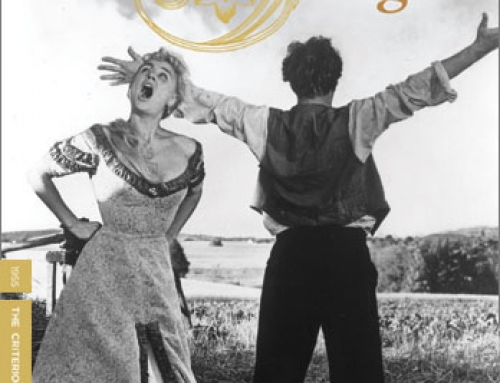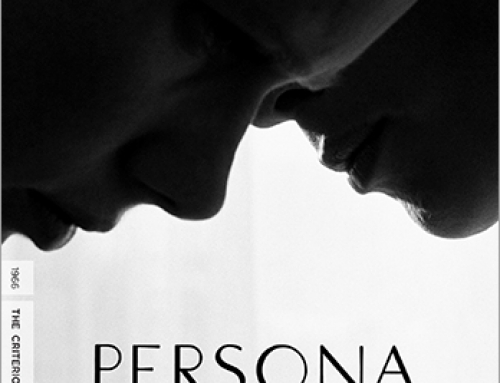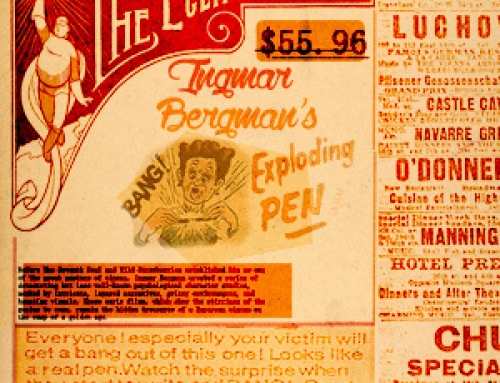Review of The Criterion Collection Blu-ray edition. Spine: #101 Release Date: March 31, 2015 Screen captures below are taken from The Criterion Collection Blu-ray disc, but resolution has been reduced from 1920x1080 to 900x506 and slightly compressed. You may click on them to view the 900x506 image.
This week, The Criterion Collection is upgrading their old DVD edition of Cries and Whispers (1972) with a beautifully restored Blu-ray edition (I’ve been waiting for this for years . . . still, please upgrade the Silence of God Trilogy), giving me a fine opportunity to revisit it and continue my informal Ingmar Bergman series. And now, as I sit to write this post, I’m overwhelmed. There are so many angles from which to approach the film. It’s a film that confronts death, and not just impending death and the aftermath of death, but the here and now of dying painfully. It’s a film about family, in this case three adult sisters who’ve come together again because one is dying painfully. It’s a film about solace, faith, religion, touch, women, class, time. But beyond the wealth of thematic angles, I’m overwhelmed because each one covers vast ranges of rich emotion. It’s a masterpiece that’s painful to watch, yet, even after all of the pain of death and of family spite, it’s surprisingly invigorating, even tender.

Clocks, chimes, pendulums, and the little mechanical figurines that adorn time pieces are often explicitly presented in Bergman’s films, and Cries and Whispers begins with a chime as a deep crimson completely fills the screen. If we take Bergman at his word and accept that the red color is the soul, it’s time is marked.
After some beautiful shots of a misty morning on a large estate, and a few shots of those beautiful clocks, we come to Agnes (Harriet Andersson, returning to work with Bergman for the first time since her tremendous performance in Through a Glass Darkly a decade before (my thoughts on that film here)), waking up miserably — we suffer through each wheeze and tight swallow — to a new day in turn of the century Sweden.
Agnes has been suffering for years (some suggest it is uterine cancer), but this time her health looks to have declined irrevocably. When I said earlier that this is a film about dying, I meant that it’s focused uncomfortably on the body’s decline. Even when Andersson played the emotionally distressed woman in Through a Glass Darkly, she was beautiful and full of live. In Cries and Whispers, we see her with parched lips and sunken eyes. Her two sisters who’ve come to care for her are repulsed, though propriety — social, not moral — demands they do what they can. It turns out they can do little, not just because they cannot make Agnes well again but because they cannot even bring themselves to offer more than a modicum of comfort despite her frequent requests for touch and comfort. After all, she knows she’s about to die and that no one can do anything for her but be with her.
On this particular morning, after she’s painfully wakened, perhaps from dreams of better days, Agnes gets out of bed and, frail, walks to a desk to write in a diary. Her sister Maria (Liv Ullmann) was tasked with staying awake to keep watch over Agnes, yet there she sleeps, calmly, in the next room. It’s a subtle reference to the moment in the Gospels when Christ is suffering while his disciples sleep nearby. If in the Bible, Christ seems to excuse the disciples because the “spirit is willing but the flesh is weak,” we soon realize that Maria’s spirit is not particularly willing either. She herself acknowledges that she’s shallow, and this waiting for death bores her. This is played out wonderfully by Ullmann and captured by Bergman, as Bergman is thankfully not willing to state all of this verbally.
The other sister is Karin (Ingrid Thullin, looking severe in her turn-of-the-century clothing and pinned up hair). Karin is also uncomfortable with this death, though she’s not necessarily terrified of touching Agnes’s dying body so long as there’s no emotion involved.
So it isn’t so much that neither sister is willing to truly offer solace to Agnes; rather, they are incapable at this point in their lives. As the film progresses, each sister gives us a look at particular memories through flashbacks. Agnes’s death is not the only time these traits have surfaced.
There’s a fourth woman in the pictures: Anna, the housemaid. Anna has been caring for Agnes for twelve years. Indeed, she’s been a presence in each of the women’s lives, playing tangential roles almost off-stage in the two sisters’ memories. Anna is saintly, and she’s dealt with death before. It isn’t necessarily her natural role, but she’s the only one who understands what Agnes needs as she passes on.
And so these three women wait for Agnes to die. It’s a fascinating dramatization of how time can sit down and suffocate you, even as it passes too quickly.
It’s not a spoiler, I hope, to reveal that Agnes dies when the film is almost exactly halfway through its run-time. When she finally dies, her sisters and Anna quickly lay out her body in to a pose more tranquil than her body allowed when still living. They then proceed to that “solemnest of industries” and prepare for the funeral . . . and manage the estate, including how best to dispose of Anna’s services, since they are no longer necessary and since Karin, ever fearful of intimacy, feels that Anna now “trails behind them a bit too familiarly.”
Up to this point, the film has been fantastic as it pushes us to these ugly moments we probably recognize all to well. However, for me the film becomes transcendent in its final act when Bergman releases himself from any obeisance to realism and we invade Anna’s consciousness, perhaps when she’s in a dream. Here Maria and Karin stand frozen to the wall and Agnes’s corpse can shed tears.
Again, for me this is an emotionally rich film. Most of the time it’s heavy and weighs me down. But there are moments of grace, such as this famous moment when Bergman references the Pieta.
And this lovely moment when we escape the deep red rooms and step into a perfect moment in the past when Agnes was not feeling too terrible and actually succeeds in stating that she has much to be grateful for.
There is intimacy in death. The film lets us see how it isn’t all negative. Indeed, it’s often our day-to-day, when time is passing at a more or less normal pace, when the body is functioning, and we can focus on something other than pain, that we fail to recognize the beauty around us. That’s not to say we succeed in respecting what’s beautiful even when our time with it is coming to an end.
Cries and Whispers . . . there’s so much to talk about, and I’ve avoided going into many of the film’s moments of terror as well as some moments of beauty. Please, go watch the film and let’s talk about it here or elsewhere.
The disc begins with a 2003 interview with Ingmar Bergman. He talks about how the film came to him. It began with an image of four women in turn-of-the-century clothing. He said that when an image like that comes along and refuses to leave it is often forebodings of a film (I love that). It runs just over 7 minutes.
Next, we get a wonderful 20-minute conversation with Harriet Andersson and Peter Cowie, recorded in 2012. They talk about her work in Through a Glass Darkly, a role that she tried to get out of because she didn’t think she could do it, and how Bergman got back in touch with her a decade later for this film. Though she is not often explicit, her tone and some of her off-hand comments are suggestive of her relationship with Bergman — it sounds like he pushed her constantly.
Peter Cowie returns to provide commentary in the next supplement, a 34-minute presentation of on-set footage. Cowie knew Bergman and his collaborators well, and his insights into the production is illuminating. Perhaps not quite as illuminating when it comes to the production of Cries and Whispers, we get a very personal look at Bergman’s life in a 52-minute 1999 interview conducted by frequent collaborator Erland Josephson. Called On Life, Death, and Love, there are years’ worth of material here. Lastly, other than the trailer, we have a 13-minute video essay by ::kogonada called On Solace, which looks at the film as three movements, each represented by one of the women waiting for Agnes’s death. ::kogonada places images side-by-side to look at how Bergman touches upon what ::kogonada think is the central theme: providing solace to someone in need.
The disc comes with a fold-out insert featuring an essay by film scholar Emma Wilson, which takes the place of the essay by Peter Cowie from the earlier edition (not that we’re missing Cowie on this release).














Superb stuff, Trevor. I love the Bergman I know more and more (perhaps inevitably) and I’m going to have to watch this over Easter. Those stills are extraordinary.
I watched an old interview with Bergman, Melvin Bragg from his South Bank Show (I’ll send you a link to that), and it’s fantastic. It’s the first time I’ve seen an interview with him: what a delightful bloke he was, first and foremost. Loved actors, and they loved him back, was the antithesis to Hitchcock in many respects including that one. And some of his responses are unforgettable. For example: “I think with film you need to take reality, certain details, carefully chosen, and of course this isn’t reality, it’s incomplete. But if you get it right, it can be an exact mirror.”
I can’t believe it…I Haven’t seen this Bergman film. I keep meaning to have a bit of a Bergman session as I haven’t watched any in ages. Maybe I should start off with Cries and Whispers. Great review by the way Trevor.
Lee and Jonathan, I hope you both watch it soon as I’d love to chat more about it!
I’d also like you to rank your Bergman films for me. He’s my favorite director, so I love the thought of others delving into his work!
I will get to it!
I haven’t seen enough Bergman, clearly – I know Winter Light is your favourite and I also know that, having just checked, it’s £43 to buy(!?!) so I’ll pray it hits the TV soon. And there are all those early films I know nothing about. So I’m stuck with a handful, and I’ll say Wild Strawberries just now is my favourite. Seventh Seal was for a good while my favourite film but I probably overwatched it. Persona is a film I admire a great deal but don’t especially love. And I’m not sure I’ve seen anything else, certainly not in a long time. I will put that right.
Ok Trevor, as I keep a list of these things, here goes, marked out of 5:
Fanny and Alexander (4)
Summer Interlude (4)
Summer With Monika (4)
The Silence (4)
Wild Strawberries (4)
Winter Light (4)
Journey Into Autumn (3)
Persona (3)
Saraband (3)
Scenes from a Marriage (3)
Smiles of a Summer Night (3)
The Face (3)
The Seventh Seal (3)
The Virgin Spring (3)
Through a Glass Darkly (3)
After the Rehearsal (2)
I haven’t seen any Bergman films for a while though so I can’t remember too much about some of them. And I can be quite harsh with my ratings but a 3 rating isn’t bad in my book.
I’ve been itching to watch the full version of Fanny and Alexander for a while now and so I’ve just ordered a copy.
Thanks for indulging me :-) . We are quite different, Jonathan! My top ten is:
-Winter Light
-Wild Strawberries
-Persona
-Smiles of a Summer Night
-Cries and Whispers
-Fanny and Alexander
-Through a Glass Darkly
-Summer Interlude
-The Seventh Seal
-The Virgin Spring
My top six are each five-star movies in my own rating system!
I still need to see a few of the main ones, I think, like The Magician, Hour of the Wolf, Autumn Sonata and Scenes from a Marriage.
Lee, I’d be interested in your thoughts on Persona. Some of these are films I at first admired but then came to love because I simply couldn’t shake them and eventually, well, it turned into true joy. I’d put Persona and Through a Glass Darkly there, both taking me several watches to get there, both resisting me quite a bit, but both films I just couldn’t shake.
Jonathan, I’ve never seen the shorter version of Fanny and Alxeander; I’ll be interested if the longer version works even better for you.
I watched the full five-hour version of Fanny and Alexander over Easter – I watched it in two parts and it was very impressive. A copy of Cries and Whispers arrived today from Lovefilm so I’ll aim to watch that soon as well. I can sense a Bergman season approaching!
Please let me know when you get through Cries and Whispers, Jonathan. I’m going through a Renoir season simultaneously with my Kurosawa season, and it’s all very exciting!